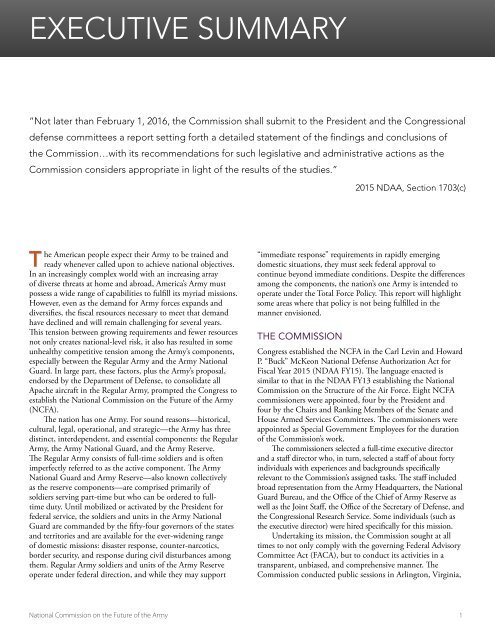THE FUTURE OF THE ARMY
NCFA_Full%20Final%20Report_0
NCFA_Full%20Final%20Report_0
You also want an ePaper? Increase the reach of your titles
YUMPU automatically turns print PDFs into web optimized ePapers that Google loves.
EXECUTIVE SUMMARY<br />
“Not later than February 1, 2016, the Commission shall submit to the President and the Congressional<br />
defense committees a report setting forth a detailed statement of the findings and conclusions of<br />
the Commission…with its recommendations for such legislative and administrative actions as the<br />
Commission considers appropriate in light of the results of the studies.”<br />
2015 NDAA, Section 1703(c)<br />
The American people expect their Army to be trained and<br />
ready whenever called upon to achieve national objectives.<br />
In an increasingly complex world with an increasing array<br />
of diverse threats at home and abroad, America’s Army must<br />
possess a wide range of capabilities to fulfill its myriad missions.<br />
However, even as the demand for Army forces expands and<br />
diversifies, the fiscal resources necessary to meet that demand<br />
have declined and will remain challenging for several years.<br />
This tension between growing requirements and fewer resources<br />
not only creates national-level risk, it also has resulted in some<br />
unhealthy competitive tension among the Army’s components,<br />
especially between the Regular Army and the Army National<br />
Guard. In large part, these factors, plus the Army’s proposal,<br />
endorsed by the Department of Defense, to consolidate all<br />
Apache aircraft in the Regular Army, prompted the Congress to<br />
establish the National Commission on the Future of the Army<br />
(NCFA).<br />
The nation has one Army. For sound reasons—historical,<br />
cultural, legal, operational, and strategic—the Army has three<br />
distinct, interdependent, and essential components: the Regular<br />
Army, the Army National Guard, and the Army Reserve.<br />
The Regular Army consists of full-time soldiers and is often<br />
imperfectly referred to as the active component. The Army<br />
National Guard and Army Reserve—also known collectively<br />
as the reserve components—are comprised primarily of<br />
soldiers serving part-time but who can be ordered to fulltime<br />
duty. Until mobilized or activated by the President for<br />
federal service, the soldiers and units in the Army National<br />
Guard are commanded by the fifty-four governors of the states<br />
and territories and are available for the ever-widening range<br />
of domestic missions: disaster response, counter-narcotics,<br />
border security, and response during civil disturbances among<br />
them. Regular Army soldiers and units of the Army Reserve<br />
operate under federal direction, and while they may support<br />
“immediate response” requirements in rapidly emerging<br />
domestic situations, they must seek federal approval to<br />
continue beyond immediate conditions. Despite the differences<br />
among the components, the nation’s one Army is intended to<br />
operate under the Total Force Policy. This report will highlight<br />
some areas where that policy is not being fulfilled in the<br />
manner envisioned.<br />
<strong>THE</strong> COMMISSION<br />
Congress established the NCFA in the Carl Levin and Howard<br />
P. “Buck” McKeon National Defense Authorization Act for<br />
Fiscal Year 2015 (NDAA FY15). The language enacted is<br />
similar to that in the NDAA FY13 establishing the National<br />
Commission on the Structure of the Air Force. Eight NCFA<br />
commissioners were appointed, four by the President and<br />
four by the Chairs and Ranking Members of the Senate and<br />
House Armed Services Committees. The commissioners were<br />
appointed as Special Government Employees for the duration<br />
of the Commission’s work.<br />
The commissioners selected a full-time executive director<br />
and a staff director who, in turn, selected a staff of about forty<br />
individuals with experiences and backgrounds specifically<br />
relevant to the Commission’s assigned tasks. The staff included<br />
broad representation from the Army Headquarters, the National<br />
Guard Bureau, and the Office of the Chief of Army Reserve as<br />
well as the Joint Staff, the Office of the Secretary of Defense, and<br />
the Congressional Research Service. Some individuals (such as<br />
the executive director) were hired specifically for this mission.<br />
Undertaking its mission, the Commission sought at all<br />
times to not only comply with the governing Federal Advisory<br />
Committee Act (FACA), but to conduct its activities in a<br />
transparent, unbiased, and comprehensive manner. The<br />
Commission conducted public sessions in Arlington, Virginia,<br />
National Commission on the Future of the Army 1


